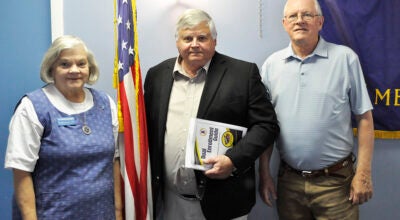Enrollment grows in both school systems for first time in years
Published 3:00 am Saturday, October 21, 2017
Local schools have submitted their enrollment numbers for the new school years and things are looking up for the public school systems.
Dr. Lee Hicks, superintendent of Troy City Schools (TCS), said enrollment numbers are up for the first time in his seven-year tenure.
“Enrollment has been trending down since before my arrival,” Hicks said. “Student population had dropped before I arrived.”
After losing students for more than seven consecutive years, enrollment finally rose for the system by 0.6 percent this year. The system enrolled 1,893 students last year and has counted 1,903 this year.
For public schools, enrollment totals affect both state and local funding. The state sends funding to school systems based on an algorithm that takes into account each school’s enrollment, referred to as ADM or Average Daily Membership. This figure is averaged out over the first 20 days after Labor Day to better reflect enrollment than a head count on any one day, Hicks said.
The enrollment is then divided by a divisor set by the State Board of Education each year, one for kindergarten through grade 3, another for grades 4 through 6, one for grades 7 through 8 and one for grades 9 through 12.
The resulting number is how many “teaching units” the state will fund for the school system in that grade level. Each teacher is salaried based on a matrix provided by the state.
Locally, the two school systems split two county sales taxes. The first is a 1-cent tax set aside solely for the schools to split. The other is another 1-cent tax of which the county appropriates $150,000 to other agencies before splitting the remainder with the school systems. The county gets 25 percent of the remaining money and the schools split the remaining 75 percent based on enrollment.
Pike County Schools typically receives about 52 to 53 percent of that money, matching the percentage of students served in the county.
Hicks said this year’s growth will allow the Troy system to get more of that money.
“We’ll gain some additional funding from our split with the county,” Hicks said. “This would increase us about $25,000. What definitely helps us though is the addition of teaching units that will allow us to work with students next year to strengthen existing programs.”
While the Pike County Schools (PCS) system hasn’t gone as long as TCS without growth, the system has seen declines for the past two years and has had decreases in enrollment for four of the past five years. Enrollment peaked in the 2014-2015 school year with 2,171 students enrolled in the system, but dropped 4.9 percent to 2,065 students last year.
This year, enrollment grew again by 40 students, an increase of 1.9 percent.
“I think there will always be a natural ebb and flow to enrollment,” Bazzell said. “However, I also believe that we will see a slow growth trend over the next several years due to improvement in the economy and the success we have had in recruiting new business and industry to Pike County.”
Even though enrollment totals affect funding models, Bazzell said school board officials don’t spend much time focused on enrollment specifics.
“All parents select schools for their children that they feel best meets the needs of their children and family. Our job is to provide schools that are well kept and most of all safe. We work every day to make sure we are responsive to any concerns parents may have and to make sure communications occur in a manner that is courteous and polite. Finally, we work to provide quality educational opportunities … If we do these things, and continue to expand opportunities, then parents will choose us more often than not.”
Hicks also said that enrollment can be influenced only by focusing on improving the school system.
“Ultimately our job is to make our students successful,” Hicks said. “So many factors play into how many are enrolled.”
Both Bazzell and Hicks pointed to expanded opportunities at the schools as a driver of enrollment.
“Ultimately, increased standards and opportunities were going to take care of themselves,” Hicks said. “I think that’s what has allowed us to grow. We’re seeing initiatives we’ve put in place over the years pay off. We’ve increased AP courses and increased standards and offerings for middle and high school students.
“For the last seven years we’ve been focusing on changing the talk at the dinner table; that was very critical to us. Everybody wanted to focus on things that weren’t going in right instead of what is going right. We’re increasing the rigor of the classes. People think if you make something harder people will go elsewhere, but this is what the community wanted. Going to the block system at the high school allowed students to balance their schedules out so they can do everything they want to do.”
Bazzell said Pike County Schools has seen success by offering advanced academic programs.
“Pike County high school age students have the opportunity to select from nine different Academy programs and earn an associate degree at no cost; our upper elementary and middle school STEM initiatives are second to none, and our Virtual School program has been nationally recognized,” Bazzell said. “Where else in America, at the high school level; can a student earn a high school diploma, an associate degree from a quality post-secondary institution like Troy University, and their private pilot license at zero cost? This is only one of the great programs we have. We have made great progress across all grade levels and subject areas and we hope to announce new initiatives this spring that are even more exciting. Most of all, it is always about the people and we have been able to recruit and retain wonderful employees at all levels and I am proud of them all.”
Improvement in the school systems isn’t the only factor that can bring about that growth; Hicks and Bazzell said the school systems are inherently tied to community growth and development.
“We are deeply tied to business and industry in Pike County.,” Bazzell said. “Our partnership with the Pike County Economic Development Corporation has existed for many years. When a business and industry prospect is considering Pike County, we want to be viewed as an asset and consider our self as part of the recruitment team. Our goal is to provide a quality education to their employees if they locate here; and secondly, we are willing to partner with new business and industry to assist in their training needs. Our commitment to potential new business and industry includes a willingness to build programs within our existing programs that are skill-specific for any prospective employer. “
Hicks commended the partnerships that exist between the school system, the City of Troy and Troy University for bringing the potential for growth.
“What people don’t realize is you have to have all entities working together from the school system to the City of Troy and its residents and Troy University,” Hicks said. “We look at every day as we’re a business. We’re trying to impress our stakeholders: our students and parents. We want to make sure we offer advanced courses and opportunities for students because that’s ultimately what brings people in when they look at systems. Public systems get looked at as not caring. But we – and I think Dr. Bazzell has the same mentality – we’re constantly looking to expand things.
“I want to thank Mayor Reeves and the city council. The partnerships created with all three entities have been very strong I think that they’re second to none. From all the dual enrollment programs to facilities to working together on a multitude of things goes to show this community is on an upward swing.”
Although Pike Liberal Arts School didn’t see the same growth as the public schools this year – enrollment fell 4 percent from last year – headmaster Becky Baggett said the school is still near capacity and looking to expand.
“We’ve been growing for the past three years and we’re still above 500 students,” Baggett said. “And that’s not to say by the end of this year that we won’t be above where we were last year. We get people moving into the area throughout the year and after Christmas.”
PLAS does not receive state funding, relying instead solely on tuition to fund programs.
“If you live in a community high in poverty, it’s going to be very difficult for parents to send kids to private school,” Bagget said. “Our tuition is among the lowest of AISA schools; we try to keep it at a level that family can afford it, but if the economy is bad, some families have to withdraw their students or give up vacation time.”
Baggett said with people having to pay out of pocket to send their kids to a private school, providing quality education and extracurricular or academic opportunities is important, as well as the ability to bring Christian principles into the classroom.
“Some people prefer the Christian atmosphere because we teach Bible through every grade,” Baggett said. “We offer something the others don’t, and I personally feel that’s important. The public school’s hands are tied as far as that goes; but we can do that because we’re private. That’s one point and another point is we prepare every student who enters here for college. We don’t have federal programs that tie your hands because we are private; we can excel our programs a little more. For us, parents are paying for a quality education. We have to continuously reevaluate and see weaknesses and strengths and make new things available to excel and do great.”





